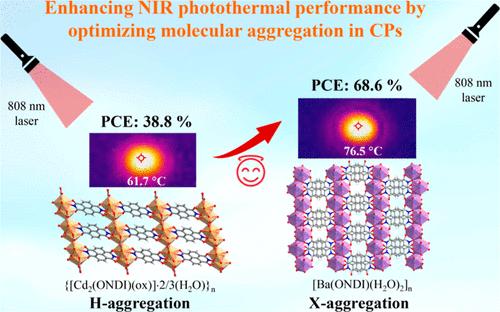当前位置:
X-MOL 学术
›
Inorg. Chem.
›
论文详情
Our official English website, www.x-mol.net, welcomes your
feedback! (Note: you will need to create a separate account there.)
Enhancing Near-Infrared Photothermal Performance by Molecular Aggregation Optimization in Semiconductive Coordination Polymers
Inorganic Chemistry ( IF 4.3 ) Pub Date : 2024-11-13 , DOI: 10.1021/acs.inorgchem.4c03580 Yong Yan, Zhen-Yu Li, Kong-Gang Qu, Harald Krautscheid, Ning-Ning Zhang
Inorganic Chemistry ( IF 4.3 ) Pub Date : 2024-11-13 , DOI: 10.1021/acs.inorgchem.4c03580 Yong Yan, Zhen-Yu Li, Kong-Gang Qu, Harald Krautscheid, Ning-Ning Zhang

|
Near-infrared (NIR) photothermal conversion materials have recently received widespread attention due to their potential in diverse applications. However, highly efficient organic-based NIR photothermal agents remain limited. Developing strategies to enhance the efficiency of NIR photothermal materials and elucidating the relationship between the NIR photothermal performance and molecular aggregation are highly desired. Herein, we report two coordination polymers {[Cd2(ONDI)(ox)]·2/3(H2O)}n (1) and [Ba(ONDI)(H2O)2]n (2), in which the ONDI2– ligands assemble into different π–π stacking arrangements. Compound 1 exhibits H-aggregation, while compound 2 displays X-aggregation. The X-aggregation in compound 2 extends the optical absorption into the NIR region and enhances the absorption intensity. Consequently, compound 2 demonstrates a 1.8-fold increase in NIR photothermal efficiency (68.6%) compared to compound 1 (38.8%), attributed to more effective π–π interactions in X-aggregation. In addition, both compounds show semiconductive properties, with conductivities of 2.1 × 10–7 S/cm for compound 1 and 3.0 × 10–7 S/cm for compound 2 at 30 °C in a nitrogen atmosphere. These properties arise from the synergistic effects of “band-like” charge transport within crystals and “hopping” charge transport across grain boundaries. By integration of their NIR photothermal effects and semiconductive properties, compounds 1 and 2 show interesting NIR photoelectrical responses.
中文翻译:

通过半导体配位聚合物中的分子聚集优化提高近红外光热性能
近红外 (NIR) 光热转换材料因其在各种应用中的潜力而最近受到广泛关注。然而,高效的有机基 NIR 光热剂仍然有限。非常需要开发策略来提高 NIR 光热材料的效率并阐明 NIR 光热性能与分子聚集之间的关系。在此,我们报道了两种配位聚合物 {[Cd2(ONDI)(ox)]·2/3(H2O)}n (1) 和 [Ba(ONDI)(H2O)2]n (2),其中 ONDI2-配体组装成不同的 π-π 堆叠排列。化合物 1 显示 H 聚集,而化合物 2 显示 X 聚集。化合物 2 中的 X 聚集将光吸收扩展到 NIR 区域并增强吸收强度。因此,化合物 2 的 NIR 光热效率 (68.6%) 比化合物 1 (38.8%) 高 1.8 倍,这归因于 X 聚集中更有效的 π-π 相互作用。此外,这两种化合物都显示出半导体特性,在 30 °C 的氮气气氛中,化合物 1 的电导率为 2.1 × 10-7 S/cm,化合物 2 的电导率为 3.0 × 10-7 S/cm。这些特性源于晶体内“带状”电荷传输和跨晶界“跳跃”电荷传输的协同效应。通过整合它们的 NIR 光热效应和半导体特性,化合物 1 和 2 显示出有趣的 NIR 光电响应。
更新日期:2024-11-14
中文翻译:

通过半导体配位聚合物中的分子聚集优化提高近红外光热性能
近红外 (NIR) 光热转换材料因其在各种应用中的潜力而最近受到广泛关注。然而,高效的有机基 NIR 光热剂仍然有限。非常需要开发策略来提高 NIR 光热材料的效率并阐明 NIR 光热性能与分子聚集之间的关系。在此,我们报道了两种配位聚合物 {[Cd2(ONDI)(ox)]·2/3(H2O)}n (1) 和 [Ba(ONDI)(H2O)2]n (2),其中 ONDI2-配体组装成不同的 π-π 堆叠排列。化合物 1 显示 H 聚集,而化合物 2 显示 X 聚集。化合物 2 中的 X 聚集将光吸收扩展到 NIR 区域并增强吸收强度。因此,化合物 2 的 NIR 光热效率 (68.6%) 比化合物 1 (38.8%) 高 1.8 倍,这归因于 X 聚集中更有效的 π-π 相互作用。此外,这两种化合物都显示出半导体特性,在 30 °C 的氮气气氛中,化合物 1 的电导率为 2.1 × 10-7 S/cm,化合物 2 的电导率为 3.0 × 10-7 S/cm。这些特性源于晶体内“带状”电荷传输和跨晶界“跳跃”电荷传输的协同效应。通过整合它们的 NIR 光热效应和半导体特性,化合物 1 和 2 显示出有趣的 NIR 光电响应。


















































 京公网安备 11010802027423号
京公网安备 11010802027423号